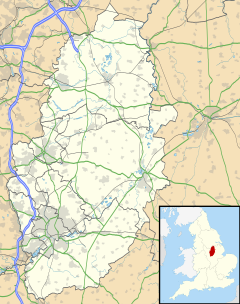Nottingham Exchange was built in the Market Place in Nottingham between 1724 and 1726 as the main offices of the Nottingham Corporation.
| Nottingham Exchange | |
|---|---|
 The Exchange ca. 1920 by Arthur Spooner | |
| General information | |
| Location | Old Market Square |
| Town or city | Nottingham |
| Country | England |
| Coordinates | 52°57′08″N 1°08′52″W / 52.952162°N 1.147844°W |
| Construction started | 1724 |
| Completed | 1726 |
| Demolished | 1926 |
| Cost | £2,400 |
| Client | Nottingham Corporation |
| Design and construction | |
| Architect(s) | Marmaduke Pennell |
History
editThe Nottingham Exchange was erected between 1724 and 1726 replacing a shambles of buildings on the same site. It cost £2,400 (£313,928 in 2015) [1] and comprised a four-storey, eleven bay frontage 123 feet (37 m) long.[2] The architect was the mayor, Marmaduke Pennell.[3] The corporation offices moved here from Nottingham Guild Hall.[4]
A clock was presented for the Exchange by 1728 by the famous clock builder James Woolley of Codnor, and in return he was made a Burgess of Nottingham.[5]
The building was reconstructed between 1814 and 1815 at a cost of £14,000[6] (£935,194 in 2015).[1] This moved the main staircase from the front to the side, and gave better access to the Great Hall which was 75 feet (23 m) by 30 feet (9.1 m). The Great Hall was used for concerts, elections, balls, meetings and exhibitions.
In 1830, John Whitehurst and Son of Derby provided a new clock for the Exchange at a cost of £100 (£8,075 in 2015).[1] (The old clock was acquired by St Nicholas' Church, Nottingham and the dial from this clock is still in situ on the church tower.)
On 19 September 1836 a new dial was added to the clock by Shepperley for £46 (£3,905 in 2015)[1] and this was illuminated by a gas jet. On 26 November 1836 a fire broke out and considerable damage was caused to the building.
The Midland Railway adopted London Time at all of its stations on 1 January 1846.[7] To avoid confusion, in February 1846 the town council ordered that the town clocks be furnished with three hands, two indicating local time and the additional one the railway and post-office London time.[8]
A new clock was built in 1881 by G. & F. Cope and moved to St Helen's Church, Trowell in 1927.[5]
The Exchange was demolished in 1926 to make way for the current Nottingham Council House which occupies the same site.[9]
Nottingham Time Ball
editIn 1876 a Greenwich time ball apparatus was fixed to the Smithy-row corner of the parapet of the Nottingham Exchange. It started operation on 11 September 1876.[10] and was installed by the Corporation to indicate Greenwich Mean Time to assist with the regulation of public clocks. Operated by electrical control, the ball dropped from top to bottom of a short staff at 1pm each day.
It was removed in 1886. Its use was probably discontinued because the installation had lost both its novelty and usefulness through the more general availability of Greenwich time, and the greater accuracy of public clocks.[11]
References
edit- ^ a b c d UK Retail Price Index inflation figures are based on data from Clark, Gregory (2017). "The Annual RPI and Average Earnings for Britain, 1209 to Present (New Series)". MeasuringWorth. Retrieved 7 May 2024.
- ^ Allen's Illustrated hand book and guide to Nottingham. Richard Allen. Nottingham. 1866
- ^ Old and New Nottingham. William Howie Wylie. 1853
- ^ A centenary History of Nottingham. John Beckett. Manchester University Press. ISBN 0719040019
- ^ a b Clock and Watch Makers of Nottinghamshire. Harold H. Mather. Friends of Nottingham Museums. 1979
- ^ A centenary History of Nottingham. John Beckett. Manchester University Press. ISBN 0719040019
- ^ "Railway Time". Leicester Journal. British Newspaper Archive. 26 December 1845. Retrieved 9 September 2016 – via British Newspaper Archive.
- ^ "The Town Council of Nottingham". Lincolnshire Chronicle. British Newspaper Archive. 6 March 1846. Retrieved 9 September 2016 – via British Newspaper Archive.
- ^ Historic England. "Council House, Exchange Buildings and adjoining shops and bank (1270582)". National Heritage List for England. Retrieved 10 April 2020.
- ^ "The Nottingham Time-Ball". Nottinghamshire Guardian. England. 15 September 1876. Retrieved 26 December 2016 – via British Newspaper Archive.
- ^ Nottingham Evening Post. 6 January 1933
